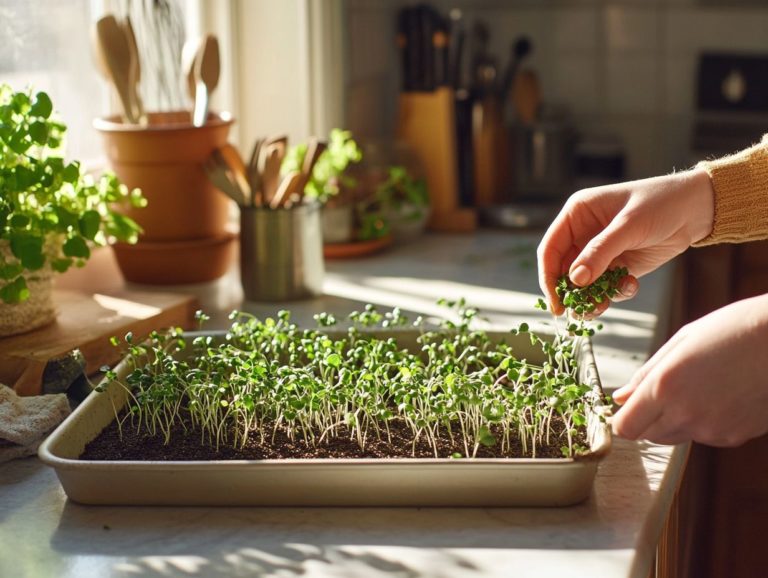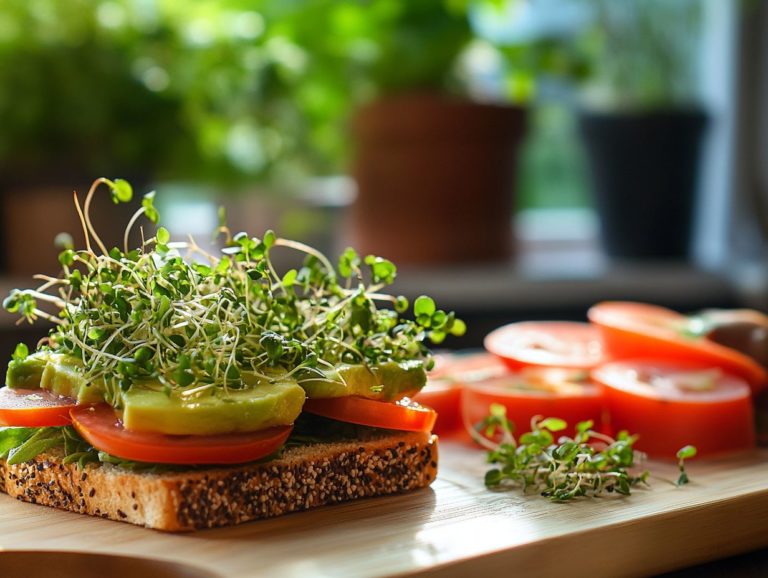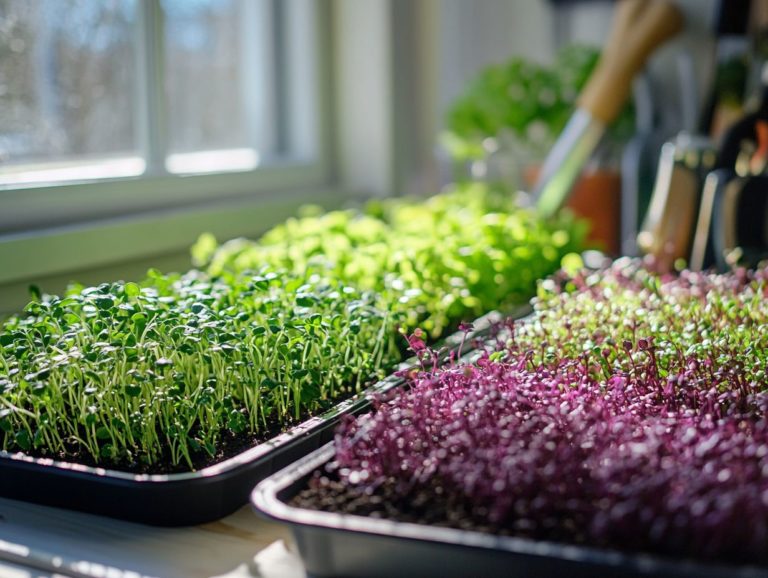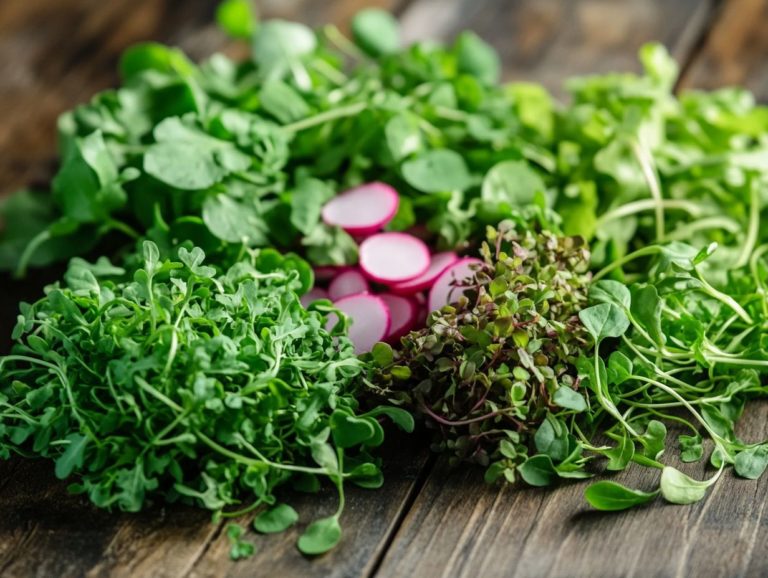How to Water Microgreens Properly?
Microgreens are small, nutrient-dense plants that possess the remarkable ability to elevate any dish. Their successful growth hinges on mastering appropriate watering techniques. This includes understanding factors affecting watering, such as humidity and light intensity.
Grasping the significance of hydration is essential, as is recognizing the consequences of both under and overwatering. This is particularly important during the germination stage of microgreens, which is when the seed begins to sprout. This guide will delve into the fundamentals of watering microgreens, providing you with a comprehensive step-by-step approach, frequency recommendations, and tailored techniques for various microgreen varieties.
This guide provides solutions for common challenges like mold and algae.
Get ready to grow with confidence! Learn how to adjust your watering techniques for different microgreens based on their specific needs!
Contents
Key Takeaways:
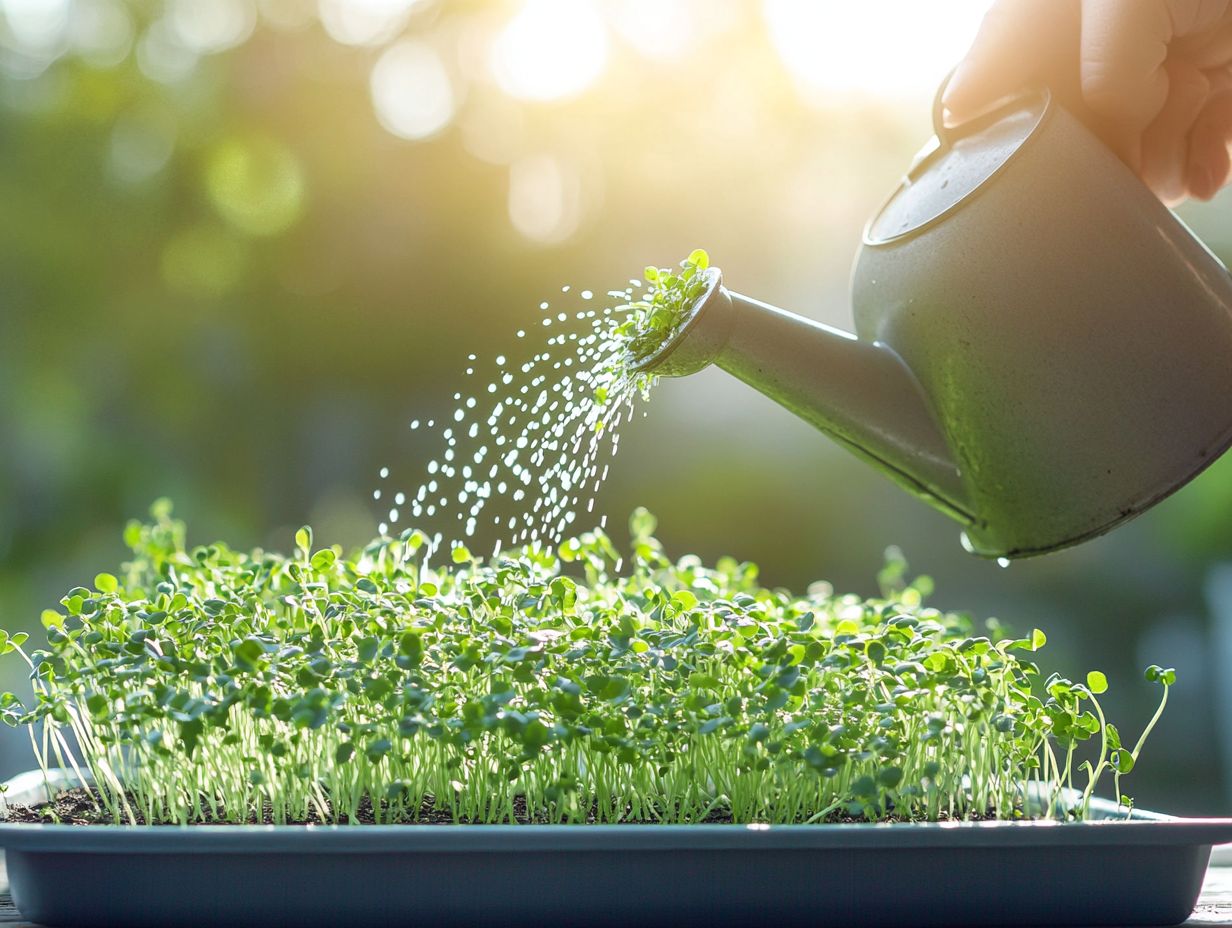
- Proper watering is crucial for the growth and health of microgreens. Under or overwatering can have negative effects on their development.
- A step-by-step guide can help ensure that microgreens are watered properly. This includes using the right amount of water and avoiding common issues like mold and algae.
- The frequency and technique of watering may vary for different types of microgreens. It is important to adjust accordingly for the best results.
What are Microgreens?
Microgreens are young, edible plants that you harvest just after the germination stage. These vibrant little greens are bursting with flavor and nutrients, making them a favorite among culinary enthusiasts and health-conscious eaters alike, especially when incorporated into dishes like salads or smoothies.
Typically grown from a variety of seeds think radish, pea, and basil these diminutive plants thrive in a well-balanced growing medium, whether it’s soil, peat moss, or coconut coir. With the right amount of light and humidity, you can maximize their growth potential.
These tiny greens aren t just a treat for the eyes; they boast an impressive nutritional profile, often containing higher concentrations of vitamins and minerals compared to their fully grown counterparts. Varieties like arugula, cilantro, and sunflower bring unique tastes and textures to the table, enhancing everything from salads to gourmet entrees.
Successfully cultivating microgreens requires you to pay attention to key factors such as soil composition, light intensity, and proper watering techniques. This care ensures a bountiful harvest. You can easily use these versatile greens in smoothies, sandwiches, and wraps, adding a nutritious punch to your everyday meals.
Importance of Proper Watering
Proper watering is crucial for the successful growth of microgreens, significantly impacting their health, nutrient absorption, and overall yield during various growth phases. Maintaining the right moisture levels is essential to promote robust root development and vibrant young microgreens.
By ensuring they thrive in optimal conditions, you can avoid the pitfalls associated with both under-watering and over-watering, allowing your microgreens to flourish beautifully. For more information, check out best practices for microgreen growth.
Effects of Under and Over Watering
Both under-watering and over-watering can wreak havoc on your young microgreens, leading to problems like stunted growth, wilting, or mold due to improper moisture levels. Recognizing the signs of water stress is essential for you as a microgreen grower to ensure your plants thrive and remain productive.
Under-watering usually shows up as yellowing leaves with crispy edges, a clear signal that your plants aren t getting the hydration they need for optimal growth. On the flip side, over-watering can turn your seedlings into leggy, weaklings prone to root rot, as the excess moisture invites pesky fungal pathogens to set up shop.
Finding the right balance is essential for your microgreens to thrive! Maintaining consistent moisture promotes vigorous growth and helps keep diseases at bay.
To tackle these challenges effectively, consider using moisture meters and establishing a regular watering schedule based on the specific needs of different microgreen varieties.
- Soil moisture meters
- Establishing a regular watering schedule
- Ensuring proper drainage in your planting containers
How to Water Microgreens
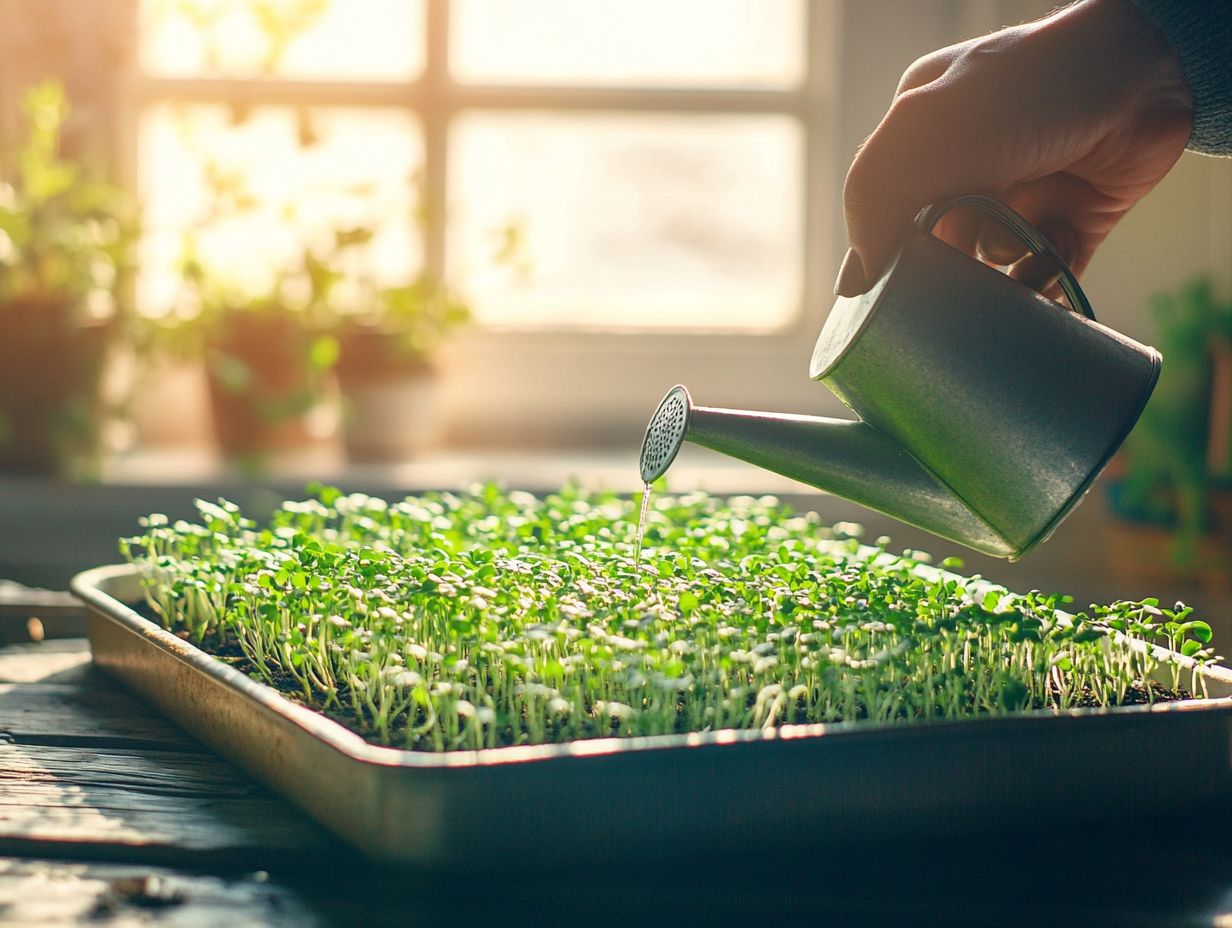
Mastering how to water microgreens is essential for their growth. Proper techniques greatly influence moisture retention and health.
Consider bottom watering and a consistent watering schedule. This helps young microgreens get the hydration they need.
Step-by-Step Guide
Understanding the watering needs of microgreens is key. Follow this guide to create optimal conditions for healthy growth.
-
Prepare your soil with a balanced mix of organic matter and good drainage. This is crucial for moisture retention.
-
Select the right watering technique. Bottom watering ensures even saturation without overwhelming delicate plants.
-
Regularly check moisture levels. Touch the soil or use a moisture meter to find the right balance.
Frequency of Watering
Finding the right frequency for watering your microgreens is vital. It changes depending on growth phase, soil, and environmental conditions.
Monitoring moisture helps you set an optimal schedule. This ensures your microgreens thrive.
Determining the Right Schedule
Your watering schedule depends on climate and moisture levels. Tailor your frequency to the needs of each microgreen variety.
Different microgreens have different watering needs. For instance, seedlings need more water than mature plants.
Humidity and temperature affect soil moisture. Regular checks are essential; use moisture meters or the finger test.
As plants mature, extend the time between waterings. Watching local weather can help you give them the right amount of water.
Watering Techniques for Different Types of Microgreens
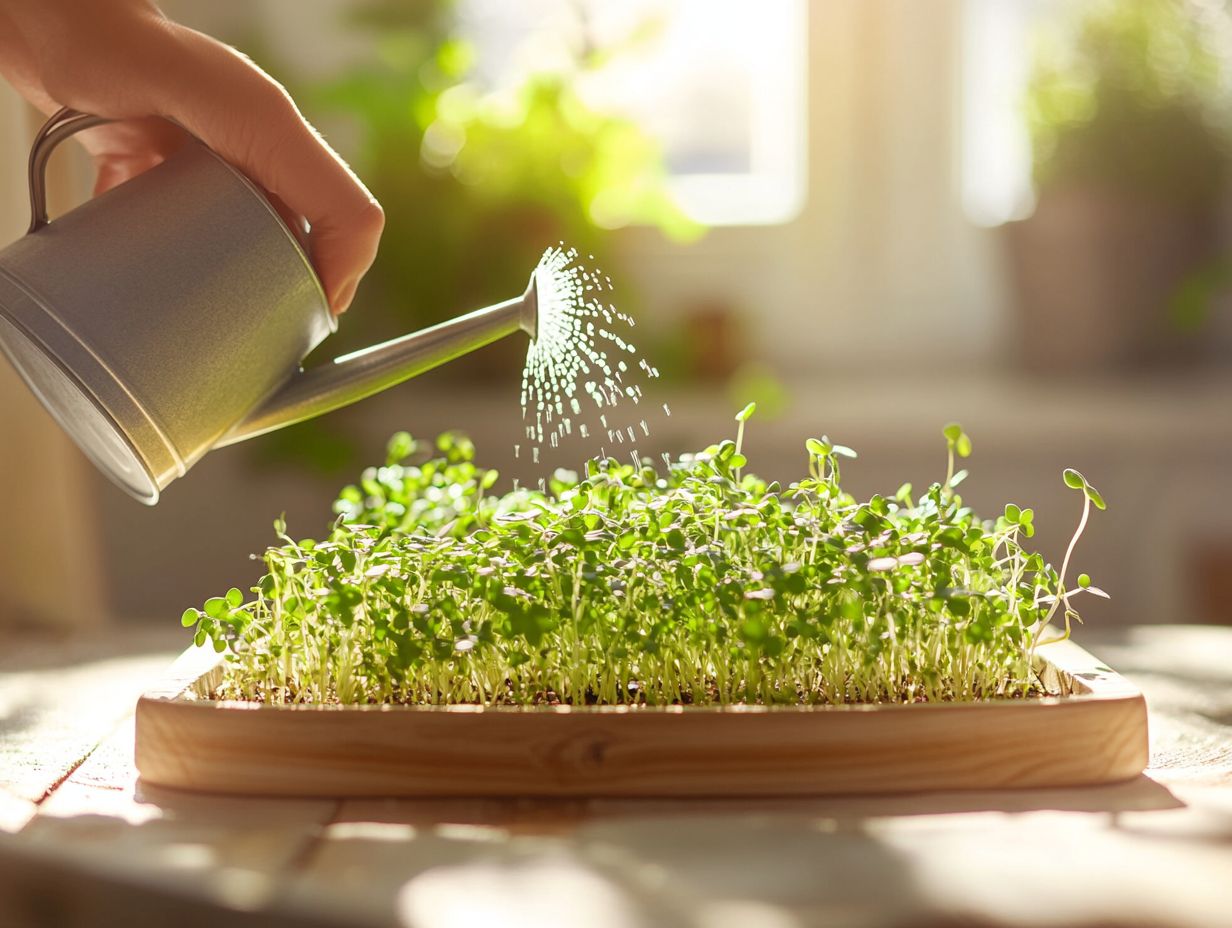
Watering techniques vary among microgreens. Understanding these differences is key to optimal growth.
Bottom watering can be especially beneficial. It minimizes soil disturbance, which is crucial for sensitive varieties.
Adjusting for Different Varieties
Adjusting your watering techniques for different microgreen varieties is essential. Each type has unique requirements regarding soil moisture and hydration strategies. By understanding these specific needs, you can create optimal conditions for each microgreen variety. This results in more vigorous growth and improved nutrient uptake.
For example, varieties like sunflower and pea thrive in slightly drier environments and require less frequent watering. In contrast, basil and cilantro flourish in consistently moist soil. Pay attention to the growth habits of each microgreen; some prefer a denser substrate that retains moisture, while others benefit from a lighter mix that drains quickly.
To effectively monitor soil moisture, consider using a tool that measures how wet your soil is. This device will help you adjust your watering schedule based on real-time data. Keep an eye on the plant leaves. Wilting or drooping indicates it’s time to adjust your watering techniques for thriving microgreens, ultimately leading to healthier microgreens.
Troubleshooting Common Watering Issues
Troubleshooting common watering issues is crucial for maintaining the vitality of your microgreens. Problems like mold and algae can easily spring up due to improper moisture levels and environmental conditions.
By recognizing the early signs of these challenges, you can take swift corrective action. This ensures that your young microgreens flourish beautifully.
Dealing with Mold, Algae, and Other Problems
Dealing with mold and algae is a challenge you ll often face as a microgreens grower. These issues typically arise from excessive watering or insufficient air movement that upsets moisture levels. Tackling these problems early is crucial to maintaining the integrity of your crop and fostering healthy growth.
To manage these concerns effectively, establishing a watering schedule that keeps the substrate moist but not oversaturated is key! Incorporating drainage solutions and opting for lightweight growing mediums can help regulate water retention. Improving airflow through proper spacing, using fans, or even implementing airflow tubes can significantly lower humidity levels. This creates an unwelcoming environment for mold and algae.
Regularly monitoring moisture levels is vital. Utilizing moisture meters will give you valuable insights into when to water, helping you maintain a balanced ecosystem for thriving microgreens. Understanding the best conditions for microgreens is also crucial for optimal growth.
Frequently Asked Questions
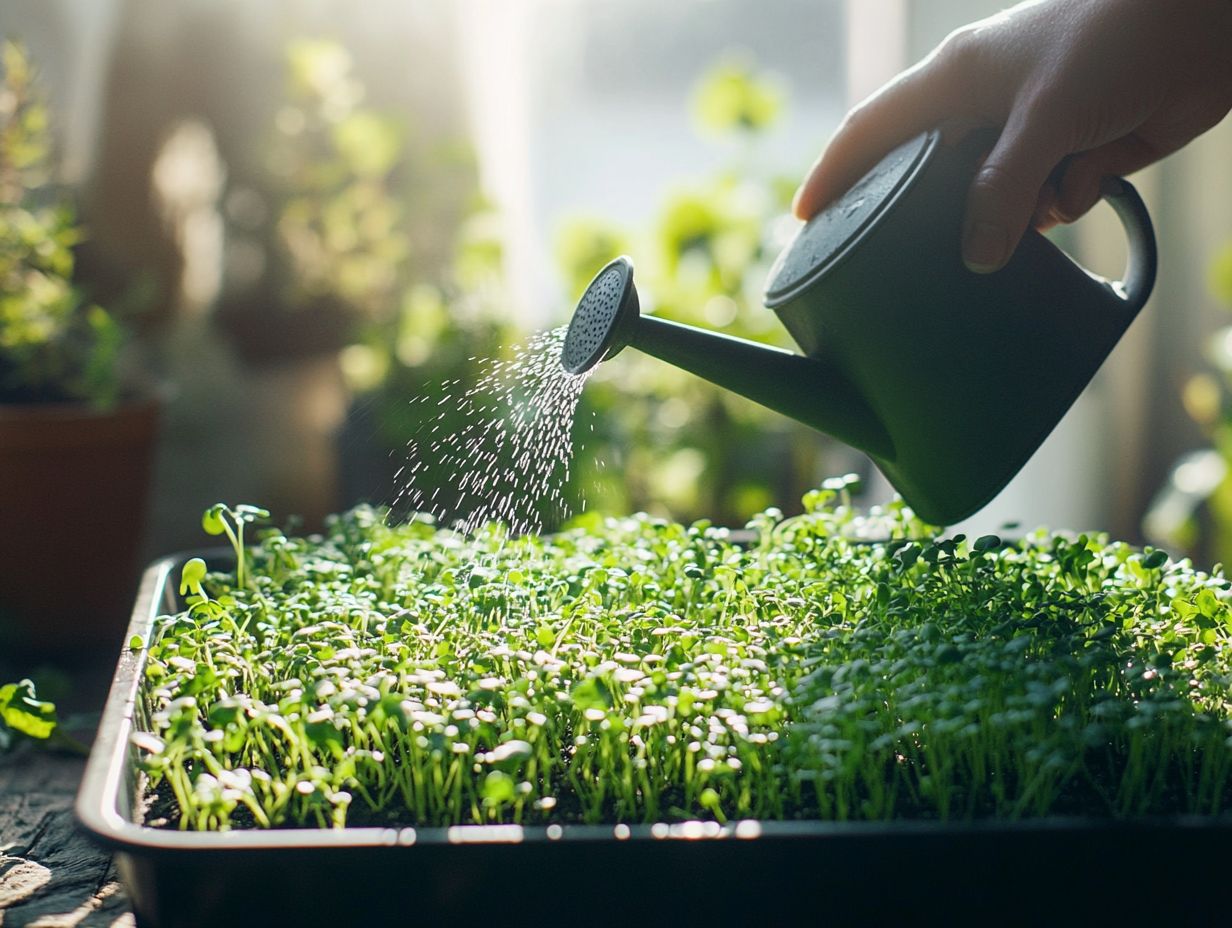
What is the best way to water microgreens properly?
The best way to water microgreens is to use a spray bottle or a watering can with a fine mist setting. This ensures that the delicate plants are not damaged by a heavy stream of water.
How often should I water my microgreens?
Water microgreens once or twice a day, depending on the temperature and humidity levels in your growing area. Keeping the soil consistently moist but not waterlogged is important.
Can I use tap water to water my microgreens?
It’s recommended to use filtered or distilled water when watering microgreens. This avoids harmful chemicals or minerals that may be present in tap water. If you do use tap water, let it sit out overnight to allow any chlorine to evaporate.
Should I water from the top or bottom of the tray?
Watering microgreens from the bottom is best. Place the tray in a shallow dish filled with water. This allows the roots to soak up the water without disturbing the delicate leaves on top.
How can I tell if my microgreens need water?
A simple way to tell if your microgreens need water is by gently pressing your finger into the soil. If it feels dry, it’s time to water. Additionally, wilting or drooping leaves can signal dehydration.
Is it possible to overwater microgreens?
Yes, overwatering microgreens is possible. It can lead to root rot and other fungal diseases. Finding a balance is crucial to avoid letting the soil become waterlogged.

